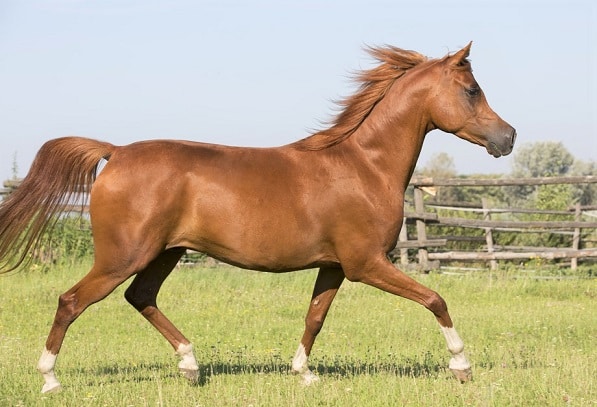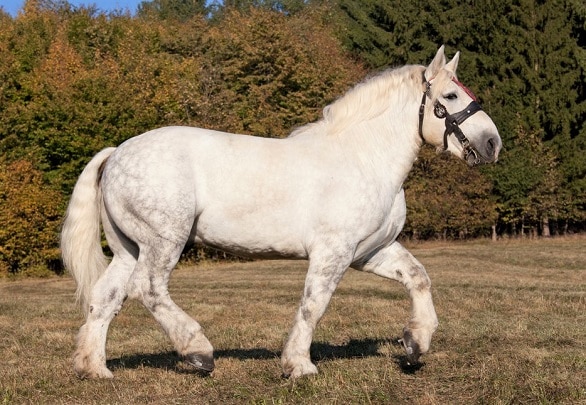In the Middle Ages, war horse breeds were highly valued animals that carried mounted warriors into battle. Several modern-day breeds were bred in medieval or ancient times for the sole purpose of aiding men in war.
The most common medieval war horse breeds were the Friesian, Andalusian, Arabian, and Percheron. These horse breeds we’re a mixture of heavy breeds ideal for carrying armored knights, and lighter breeds for hit and run or fasting moving warfare.
A collective name for all medieval warhorses was a charger. Within this category, we can distinguish destriers and coursers.
Destriers were generally taller and resembled modern draft horses. They had to be able to carry a fully armored knight, as well as their own armor. Destriers were most often stallions due to their natural aggression and tendency to fight in the heat of battle. However, the preference varied between nations.
Coursers were shorter, lighter, and swifter horses ridden unarmored during sieges and raids. They represented a highly mobile unit that was often preferred to heavy cavalry.
Although war horse breeds weren’t as distinct in the Middle Ages as they are today, many modern breeds can be traced back to destriers and coursers.
Featured image is from @lillentheshire (Instagram).
7 Common Medieval War Horse Breeds Friesian

Vera Zinkova / Shutterstock.com
These elegant, powerfully muscled war horses are commonly recognized as the descendants of medieval destriers.
Native to the Netherlands, the oldest records of Friesian-like horses date back thousands of years. Illustrations from the medieval era depict knights riding noble black horses into a battle that strongly resembles the modern breed.
The ancestors of Friesians were slightly shorter horses, around 15hh tall with a stockier conformation. Many admired them for their bravery in battle and smooth, high-quality gaits.
After the medieval period, the need for heavy war horses gradually declined. As a result, this war horse breed has received an infusion of Spanish blood to create lighter carriage horses.
The official studbook for the breed has opened in 1879. At the time, Friesians were used mainly for agricultural and draft work.
The mechanization of agriculture in the early 20th century has nearly put an end to Friesian horses. Luckily, they survived and is now a popular breed in dressage, showing, driving, and even filmmaking!
Mongolian Horse

Maxim Petrichuk / Shutterstock.com
The Mongolian Horse is an ancient war horse breed that has lived and fought alongside the Mongols for thousands of years. They became feared war horses during the rule of Genghis Khan (1206-1227) when they served as coursers. Their exceptional hardiness and stamina made them a highly valued mount on the battlefield.
Their only downside was their stout conformation, which made them slower than other war horse breeds.
According to historical sources, Mongolian warriors would always bring a small herd of horses (5-20 animals) into battle. This was to make sure they always had a fresh animal to ride, which greatly increased their chances of victory.
The Mongolian horse has stood the test of time with regard to its appearance and temperament. With a population of a whopping 3 million horses, it’s the most genetically diverse horse breed in the world.
The Mongolian horse is still the main means of transport in many parts of the country. It is also kept for its milk and for riding and racing purposes.
Andalusian

Alexia Khruscheva / Shutterstock.com
Throughout its historical development, the Andalusian was praised by several nations as one of the most talented war horses ever lived.
Also known as the “royal horse of Europe”, these graceful mounts were befit to carry kings and nobility into battle. Their muscular build, balanced gaits and bravery made the Andalusian an extremely valuable destrier.
During the Late Middle Ages, this elegant Spanish war horse breed has conquered the hearts of kings and queens across Europe. The French kings Louis XIII and Louis XIV and the king of England Henry VIII especially favored the Andalusian and widely employed them in their cavalry.
Recognized as an official breed since the 15th century, the ancestors of the Andalusian have roamed the Iberian Peninsula for tens of thousands of years. Due to their fine looks and docile temperament, Andalusians have contributed to the improvement of most modern horse breeds.
Today, the Andalusian is a versatile riding horse breed that is popular in classical dressage. It has also appeared in various historical and fantasy films, including the Lord of the Rings.
Shire

Marina Kondratenko / Shutterstock.com
The ancestors of the modern Shire horse dominated the battlefields all over medieval England.
Known as the English Great Horse during their golden ages as war horses, they were in high demand in the cavalry of Henry VIII (1509-1547). He even banned the breeding of stallions less than 15hh tall in order to maximize the average height of the horse breed.
As a result, Henry VIII created a powerful destrier of formidable size that could carry a knight in full armor with ease.
Although the rise of gunpowder has put an end to this heavy war horse breed, the Shire horse remained a popular and versatile breed. They became essential work horses of the agriculture, forestry, transportation, and brewery industries.
Despite its early medieval origins, the official Shire breed only exists since the mid-18th century. After the Second World War, their numbers decreased dramatically, but luckily the breed survived. However, they are still considered a relatively endangered horse breed.
Shire horses are still used today for forestry and promotional purposes, and well as riding and driving.
Arabian

skmj / Shutterstock.com
When you picture the delicate, fragile-looking Arabian horse, you probably wouldn’t consider it befit for medieval warfare. However, the truth is quite the opposite.
Throughout history, Arabians were more involved with war than almost any other war horse breed. From Ancient Egypt, they spread to Greece, Rome, Spain through the Muslim invasion, and via the Ottoman Empire to the rest of the world.
Arabian horses proved to be fiery, agile coursers whose speed and endurance was second to none. They were the mounts of choice for raids and later for light cavalry charges.
With the decline of heavy war horses in the Late Middle Ages, the importance of the Arabian became paramount. They were also used to add agility and refinement to other light cavalry breeds of the time.
The modern-day Arabian is just as fine and hardy as it’s medieval equivalent. A horse of outstanding beauty, it is one of the most popular breeds in the world.
Due to its intelligence and versatility, the Arabian is fit for nearly all equestrian disciplines. When it comes to endurance, this exceptional horse is yet to find a worthy rival.
Marwari

Olesya Nakipova / Shutterstock.com
Marwari coursers have served in the Indian cavalry since the Early Middle Ages. Their bravery and skilful movement made them a much sought-after war horse.
The origins of the Marwari are largely unknown. However, there are speculations that the war horse breed has had Arabian, Turkoman, and potentially Mongolian influence.
The Marwari’s prowess as a war horse transcended the borders of its native land. Although a rare breed today, the 16th century ruler of the Marwar region once held a cavalry force of over 50,000 horses!
This peculiar breed is now considered the national horse if India. It’s closely related to the Kathiawari breed, with which it shares the characteristic inward-curving ears.
Owning a Marwari had been a privilege of royalty and nobility for most of history. Today, they are versatile riding horses particularly talented in dressage and polo.
Marwaris are often crossed with Thoroughbreds to produce a larger sports type horse. They also take part in shows and religious ceremonies, wearing traditional adorned tack.
Percheron

Lenkadan / Shutterstock.com
With the classic looks of a medieval destrier, this French war horse breed was born to serve. Indeed, the ancestors of the Percheron often appeared on paintings as the mounts of armored knights.
The breed developed in the river lands of Northwestern France, where native horses were crossed with Spanish and Oriental stock.
The Percheron lived its prime days as a medieval war horse during the High and Late Middle Ages. Its natural strength and large size made this breed ideal for the French heavy cavalry.
After the decline of armored knights, the role of the Percheron has shifted towards coach pulling, agricultural and forestry work. Breeders started selecting taller animals with a focus on pulling power and docile temperament.
Starting from the 19th century, Percherons have populated the United States and are now the most frequently occurring draft horse breed there.
These large draft horses are usually grey or black in color. Most of their historical draft uses still apply today. Crossed with Thoroughbreds, Percherons also contribute to the creation of heavy hunter and police horses.
Frequently Asked Questions How big was a medieval war horse?
Medieval war horse breeds ranged between 14hh to 15hh (56 to 60 inches) in height. Selective breeding for taller and bigger horses is believed to have started as early as the 9th century as heavily armored knights became more common.
How much would a horse cost in medieval times?
A fully trained war horse in medieval times would cost tens or even hundreds of thousands of dollars in today’s money. Although a standard farm horse would be much more affordable, most common people in medieval times couldn’t afford a war horse. The price of a horse in the Middle Ages varied greatly depending on age, training level, type, purpose, and ancestry of the animal.
What is a Destrier Horse?
Destriers were a type of war horse that closely resembled today’s draft horses. Their immense power and heavy musculature allowed them to carry a fully armored knight with ease.
What horse did Alexander the Great ride?
Alexander’s legendary charger was a black stallion named Bucephalus, one of the now-extinct Thessalian horses. After his death in 326 BC, Alexander honored his horse’s bravery by founding the city of Bucephala.
Are horses still used in the military?
The military in most countries still employs horses for ceremonial purposes, as packhorses on mountainous terrain and also as patrol horses. Certain Third World countries still use horses for organized armed fights.
Featured image is from @lillentheshire (Instagram).
source: horseyhooves.com





